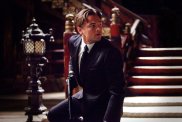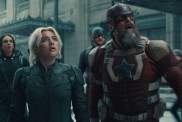Our second interview with the director

Days before Shock Till You Drop sits down to see Overture Films’ remake of George Romero’s The Crazies, director Breck Eisner got on the phone with us to continue a conversation we began on set last year. Below, Eisner talks further about production, the time constraints, the release date shift and the grim ending I heard was re-shot.
Ryan Rotten: How did the rest of principal photography go?
Breck Eisner: It went great. It’s a low budget movie by Hollywood standards. Obviously, higher budget than the Romero movie. It was a very aggressive shoot. In that entire sequence you were there for, the containment zone, I had one day to all of that. It would be nice to have two or three. But that’s how the movie was. Run and gun style. Fire under our asses. It’s an exciting way to make a movie. Stumble and you’ll never get back up. There’s a big scene in the car wash – which you put up a clip of. We have four actors in the car, three or four crazies in full make-up doing stunts. Gun fire. Squibs. Exploding glass. Water. Soap. Slippery surfaces. Visual FX and explosions. That was a tough scene that we spent time on.
Rotten: How different is your vision of this story compared to Romero’s?
Eisner: It’s very different, absolutely. For me – I know people throw around the words re-interpretation, remake – it is a re-interpretation of his movie. Definitely acknowledged to be different from the inception. That being said, I tried to stay true to the core of the original. What made it special? What made it work? From the few people who have seen it, there’s a good response to that. When I think of Romero and his early works, I think about horror but I also think about social commentary. I wanted, first, to make this a horror-thriller. Dynamic and scary, intense and frightening. But I also wanted to make sure the message in the movie wasn’t lost and in the post-9/11 world is reflected, just as the original was a reflection of post-Vietnam.
Rotten: What’s simmering beneath the surface of the original works and it’s scary in that respect, but there’s nothing that reaches out to make you jump. I’m seeing those types of gags in the trailers and clips we’ve seen from your film…
Eisner: That was the number one thing I thought about when I was making this movie. The original has a bifurcated point of view. It’s told from the point of view of the David Dutton character but it’s also told from the point of view of the military. And when you get to the latter, it’s not scary. It’s social commentary and it takes something from the movie. When I got the original draft of the remake, by Scott Kosar, it had that bifurcated point of view. It was a good draft but then we hired Ray Wright to do a revision that completely focused on the townsfolk point of view. Get rid of the military completely. It’s more realistic, it enhances the scares. It makes the movie more relatable.

Rotten: You were aiming for a fall 2009 release date, but that was pushed shortly before shooting wrapped. That must have been a relief for you.
Eisner: Oh yeah. I never thought we’d make September. I think when they locked that release date it was a way for them to get the movie going. I said, “Look, I’ll do it, but it’s not good for the edit time. It doesn’t do the movie justice.” Weeks before we finished shooting, they realized this. Luckily they had a movie to fill that gap and they were able to push us. It allowed me to do a proper post-production. We’re not cutting right to the end, but there’s cost involved to keep that process of filmmaking open. It allowed us to do it on a normal schedule. I did my cut and worked with the editors and their notes. Good filmmaking and horror movie making is about the pacing and the arc of the whole movie. It was a careful balance to play with that tension. It also allowed me to screen it to friends, have test screenings and fine-tune the movie.
Rotten: What kind of stuff were you fine-tuning other than the things you have mentioned? Were there any drastic changes between the vision you started with and the film you ended with?
Eisner: No, for example, I’ve been working on the DVD and there is a single deleted scene. There’s not a host of deleted scenes. It’s not because I don’t want them on there, it’s because there are barely any. There are parts of scenes that got deleted, but we didn’t have time on the shoot to mess around. We had to shoot what was going to be in the movie. The one scene that got cut is pretty cool and it’s right for the DVD but we didn’t have this whole big world. Areas I played on, I moved some scenes around. The opening of the movie and there is some fun stuff there. It has a montage set-up feel, it allowed me to experiment. The blueprint we set up for shooting we very much followed.

[laughs] Yes, there was. I have a very dark sensibility, I guess. The ending I wanted, from the very first moment I started this, was a very dark ending. I can’t tell you how it ends. I can’t tell you if it’s dark or light or give that away. But it’s not as dark as the unbelievably dark ending that was shot. They let me shoot it, they gave it to me, but they didn’t believe it would work. They were right, especially if we’re trying to get a bigger audience. It’s a dark movie, but this was really dark.
The Crazies opens on February 26.
For more coverage: Set Report | Director Breck Eisner Interview | Timothy Olyphant Interview | Radha Mitchell Interview | Joe Anderson Interview | Danielle Panabaker Interview | Behind the FX with Robert Hall | Video Interviews With Olyphant & Pannabaker | Video Interviews With Mitchell & Anderson
Source: Ryan Rotten, Managing Editor










